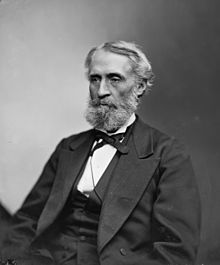LIMSwiki
Contents
Thomas L. Clingman | |
|---|---|
 Clingman photographed by Mathew Brady, c. 1860-65 | |
| United States Senator from North Carolina | |
| In office May 7, 1858 – March 11, 1861 | |
| Preceded by | Asa Biggs |
| Succeeded by | John Pool (1868) |
| Member of the U.S. House of Representatives from North Carolina | |
| In office March 4, 1853 – May 7, 1858 | |
| Preceded by | Edward Stanly |
| Succeeded by | Zebulon Vance |
| Constituency | 8th district |
| In office March 4, 1847 – March 3, 1853 | |
| Preceded by | James Graham |
| Succeeded by | Henry Shaw |
| Constituency | 1st district |
| In office March 4, 1843 – March 3, 1845 | |
| Preceded by | Kenneth Rayner |
| Succeeded by | James Graham |
| Constituency | 1st district |
| Personal details | |
| Born | Thomas Lanier Clingham July 27, 1812 Huntsville, North Carolina, U.S. |
| Died | October 3, 1897 (aged 85) Morganton, North Carolina, U.S. |
| Resting place | Riverside Cemetery |
| Political party | Democratic |
| Education | University of North Carolina, Chapel Hill (BA) |
| Military service | |
| Allegiance | Confederate States |
| Branch/service | Confederate States Army (Infantry) |
| Years of service | 1861–1865 |
| Rank | Brigadier General |
| Battles/wars | |
Thomas Lanier Clingman (July 27, 1812 – November 3, 1897), known as the "Prince of Politicians," was a Democratic member of the United States House of Representatives from 1843 to 1845 and from 1847 to 1858, and U.S. senator from the state of North Carolina between 1858 and 1861. During the Civil War, he refused to resign his Senate seat and was one of the many southern senators subsequently expelled from the Senate in absentia. He then served as a general in the Confederate States Army.
Early life
Clingman, was born in Huntsville, a small community in present-day Yadkin County, North Carolina. His parents were Jacob and Jane Poindexter Clingman and he was named for Dr. Thomas Lanier, his half uncle.[1] He was educated by private tutors and in the public schools in Iredell County, NC. Clingman graduated from the University of North Carolina in 1832, where he was a member of the Dialectic Senate of the Dialectic and Philanthropic Societies. He then studied law and was admitted to the bar in 1834 and began practice in Huntsville.
Political career

Clingman was elected to the North Carolina State House of Commons in 1835. In 1836 he moved to Asheville, North Carolina. He was a member of the North Carolina State Senate in 1840. In 1843 Clingman ran as a Whig and was elected to the 28th United States Congress, however he was defeated in his reelection bid in 1845.[2] In 1845 he fought a duel with a fellow congressman William Lowndes Yancey of Alabama. In Yancey's maiden speech on the House floor, he had impugned his opponent's integrity. Both duelists had missed. In 1847 he regained the seat and won reelection in 1849, 1851, 1853, 1855 and 1857. On May 7, 1858, he resigned after becoming a United States senator as a Democrat the previous day,[2] replacing the resigning Asa Biggs. He was reelected but was expelled from the Senate for support of the Confederacy.
Civil War
When he first entered the War, Clingman was the commander of the 25th North Carolina Infantry and took part in the Peninsula Campaign. He later commanded a brigade of infantry. Clingman's Brigade consisted of the 8th, 31st, 51st and 61st North Carolina Infantry. Clingman's Brigade fought at Goldsborough, Battery Wagner, Drewry's Bluff, Cold Harbor, Petersburg, Globe Tavern, Fort Fisher, and Bentonville.

Post-war career
After the Civil War, Clingman explored and measured mountains in western North Carolina and Tennessee. Kuwohi, Tennessee's highest mountain, also partly in North Carolina, was renamed Clingman's Dome in his honor in 1859 as Kuwohi was one of the mountains he had accurately measured, being said to be the first person to do so.[3] The mountain's name was changed back to Kuwohi in 2024.[4] He died in Morganton, North Carolina, and was buried in the Riverside Cemetery in Asheville, North Carolina.[5]
See also
- List of American Civil War generals (Confederate)
- List of United States senators expelled or censured
References
- ^ Wheeler, John H.. Reminiscences and memoirs of North Carolina and eminent North Carolinians. Columbus, Ohio: Columbus Print. Works, 1884
- ^ a b Inscoe, John C. and Gordon B. McKinney. The Heart of Confederate Appalachia: Western North Carolina in the Civil War. Chapel Hill: University of North Carolina Press, 2020. ISBN 978-0-8078-5503-4. p. 32.
- ^ Gannett, Henry (1905). The Origin of Certain Place Names in the United States. Government Printing Office. p. 85. Retrieved September 19, 2024.
- ^ Whetstone, Tyler (September 18, 2024). "Clingmans Dome renamed Kuwohi in honor of Cherokee people who consider the mountain sacred". Knoxville News Sentinel. Retrieved September 19, 2024.
- ^ "Riverside Cemetery". nps.gov. National Register of Historic Places. Retrieved 2008-02-25.
Further reading
- Eicher, John H., and David J. Eicher, Civil War High Commands. Stanford: Stanford University Press, 2001. ISBN 978-0-8047-3641-1.
- Sifakis, Stewart. Who Was Who in the Civil War. New York: Facts On File, 1988. ISBN 978-0-8160-1055-4.
- Warner, Ezra J. Generals in Gray: Lives of the Confederate Commanders. Baton Rouge: Louisiana State University Press, 1959. ISBN 978-0-8071-0823-9.
- Jeffrey, Thomas E., “Thomas Lanier Clingman: Fire Eater from the Carolina Mountains” ISBN 978-0820320236
External links
- United States Congress. "Thomas L. Clingman (id: C000524)". Biographical Directory of the United States Congress.
- . New International Encyclopedia. 1905.
- Clingman, Thomas L. "[Letter] 1855 Jan. 9, Ho[use of] Rep[resentatives to] W[illia]m H. Thomas / T[homas] L. Clingman". Southeastern Native American Documents, 1730-1842. Digital Library of Georgia. Retrieved 21 February 2018.



















